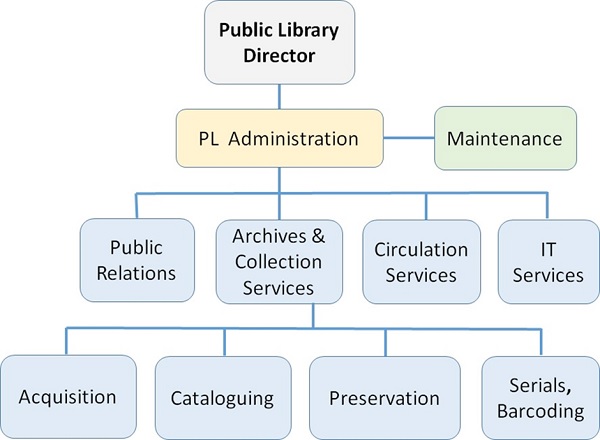
- Public Library Management - Home
- Public Library Mngmt - Overview
- General Structure
- A Brief History
- Common Terms
- HRM in Public Library
- Organizational Structure
- Public Library Mngmt - Finance
- Information Sources
- Knowledge Organization
- Library Classification
- Public Library Mngmt - Cataloging
- Information Retrieval
- Public Library Mngmt - Legislation
- Library Associations
- Automation & IT
Organizational Structure
Within a public library, the number of departments can vary depending upon its size, budget, space, and its strength in terms of the number of members.
Library management and administration is a multifaceted work of organizing, preserving, collecting, circulating, and maintaining the printed or digital resource of knowledge. It involves managing and recruiting the staff, training and developing the staff members,managing funds, and overall functioning of the library.
Take a look at the following hierarchy chart. It shows the most basic organizational structure of a public library −

Library Authority
A library authority can be an individual or a group of individuals that manages all the activities of the library as an institution such as directing, controlling, motivating, deciding, and coordinating.
Library Committee
A public library has an advisory committee that guides the operations of library, plans and monitors the overall progress of library, and is responsible for fund raising.
Types of Library Committees
Here are the common types of library committee −
Ad hoc Committee − It is a special committee of participants with foresight and intellect to perform special jobs pertaining to library growth, supervision, and management. The people in the committee take rapid and intelligent decisions though less independently.
Elected Committee − It is a body of people elected by a larger committee that delegates decision-making and operations. The elected committee needs to report to the larger parent committee.
Self-sustaining Committee − It is the body of people who created the library. It has sole authority to control the funds and library management.
Executive Committee − It is the committee to which the library authority delegates complete decision rights in some crucial matters. This committee is one which has full powers in those matters and it need not report to its library authority.
Reporting Committee − It decides some policies within certain extents. It needs to report to the authority and get approval.
Recommending Committee − It has no real power for decision-making or operations. It can recommend proposals on library government, which the library authority approves.
Roles of Public Library Departments
The roles of various public library departments are as follows −
Public Library Director − Establishes strategies, policies, and goals.
PL Administration − Handles overall library operations, enforces policies set by director and planning.
Maintenance − Ensures smooth running of facilities by housekeeping, and maintaining ground, electrical gadgets, and plumbing.
Public Relations − Engages into promotions, informing the public about upcoming events, crisis management.
Archives and Collection Services − Acquires, catalogues, manages, and preserves important records, sets serial numbers or barcodes, handles the rare or fragile knowledge resources with due care.
Circulation Services − Manages issuing and receiving returned material, tracks fines and dues by users due to late return or loss of material.
IT Services − Manages library network, computers, and audiovisual devices, updates software.
Care & Preservation of Library Resources
The library resource users as well as the staff needs to be aware of the way the library material needs to be handled and they should follow the guidelines with due care. Care and prevention prolongs the valuable knowledge resource kept in the library, may it be in the print or the digital format.
For care and preservation of library material, the given rules are followed −
Stitching in time − Repairing the minor damages while they are small.
Encouraging proper handling − Training the staff on the type of material, its durability, and the care required for the knowledge resources.
Communicating clearly − There should be a clear communication among staff members about responsibilities of caring and preserving.
Readiness − Assessing the risk and equipping the library for handling disasters such as fire breaking out. Prohibiting smoking and drinking in the areas where knowledge resources are stored and accessed.